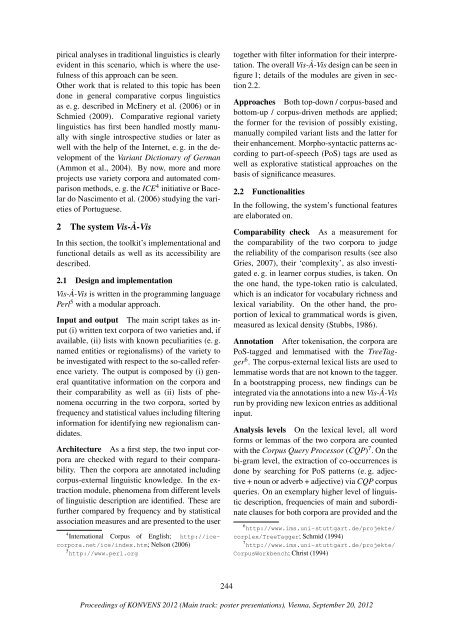paper - EURAC
paper - EURAC
paper - EURAC
You also want an ePaper? Increase the reach of your titles
YUMPU automatically turns print PDFs into web optimized ePapers that Google loves.
pirical analyses in traditional linguistics is clearly<br />
evident in this scenario, which is where the usefulness<br />
of this approach can be seen.<br />
Other work that is related to this topic has been<br />
done in general comparative corpus linguistics<br />
as e. g. described in McEnery et al. (2006) or in<br />
Schmied (2009). Comparative regional variety<br />
linguistics has first been handled mostly manually<br />
with single introspective studies or later as<br />
well with the help of the Internet, e. g. in the development<br />
of the Variant Dictionary of German<br />
(Ammon et al., 2004). By now, more and more<br />
projects use variety corpora and automated comparison<br />
methods, e. g. the ICE 4 initiative or Bacelar<br />
do Nascimento et al. (2006) studying the varieties<br />
of Portuguese.<br />
2 The system Vis-À-Vis<br />
In this section, the toolkit’s implementational and<br />
functional details as well as its accessibility are<br />
described.<br />
2.1 Design and implementation<br />
Vis-À-Vis is written in the programming language<br />
Perl 5 with a modular approach.<br />
Input and output The main script takes as input<br />
(i) written text corpora of two varieties and, if<br />
available, (ii) lists with known peculiarities (e. g.<br />
named entities or regionalisms) of the variety to<br />
be investigated with respect to the so-called reference<br />
variety. The output is composed by (i) general<br />
quantitative information on the corpora and<br />
their comparability as well as (ii) lists of phenomena<br />
occurring in the two corpora, sorted by<br />
frequency and statistical values including filtering<br />
information for identifying new regionalism candidates.<br />
Architecture As a first step, the two input corpora<br />
are checked with regard to their comparability.<br />
Then the corpora are annotated including<br />
corpus-external linguistic knowledge. In the extraction<br />
module, phenomena from different levels<br />
of linguistic description are identified. These are<br />
further compared by frequency and by statistical<br />
association measures and are presented to the user<br />
4 International Corpus of English; http://icecorpora.net/ice/index.htm;<br />
Nelson (2006)<br />
5 http://www.perl.org<br />
244<br />
together with filter information for their interpretation.<br />
The overall Vis-À-Vis design can be seen in<br />
figure 1; details of the modules are given in section<br />
2.2.<br />
Approaches Both top-down / corpus-based and<br />
bottom-up / corpus-driven methods are applied;<br />
the former for the revision of possibly existing,<br />
manually compiled variant lists and the latter for<br />
their enhancement. Morpho-syntactic patterns according<br />
to part-of-speech (PoS) tags are used as<br />
well as explorative statistical approaches on the<br />
basis of significance measures.<br />
2.2 Functionalities<br />
In the following, the system’s functional features<br />
are elaborated on.<br />
Comparability check As a measurement for<br />
the comparability of the two corpora to judge<br />
the reliability of the comparison results (see also<br />
Gries, 2007), their ‘complexity’, as also investigated<br />
e. g. in learner corpus studies, is taken. On<br />
the one hand, the type-token ratio is calculated,<br />
which is an indicator for vocabulary richness and<br />
lexical variability. On the other hand, the proportion<br />
of lexical to grammatical words is given,<br />
measured as lexical density (Stubbs, 1986).<br />
Annotation After tokenisation, the corpora are<br />
PoS-tagged and lemmatised with the TreeTagger<br />
6 . The corpus-external lexical lists are used to<br />
lemmatise words that are not known to the tagger.<br />
In a bootstrapping process, new findings can be<br />
integrated via the annotations into a new Vis-À-Vis<br />
run by providing new lexicon entries as additional<br />
input.<br />
Analysis levels On the lexical level, all word<br />
forms or lemmas of the two corpora are counted<br />
with the Corpus Query Processor (CQP) 7 . On the<br />
bi-gram level, the extraction of co-occurrences is<br />
done by searching for PoS patterns (e. g. adjective<br />
+ noun or adverb + adjective) via CQP corpus<br />
queries. On an exemplary higher level of linguistic<br />
description, frequencies of main and subordinate<br />
clauses for both corpora are provided and the<br />
6 http://www.ims.uni-stuttgart.de/projekte/<br />
corplex/TreeTagger; Schmid (1994)<br />
7 http://www.ims.uni-stuttgart.de/projekte/<br />
CorpusWorkbench; Christ (1994)<br />
Proceedings of KONVENS 2012 (Main track: poster presentations), Vienna, September 20, 2012

















